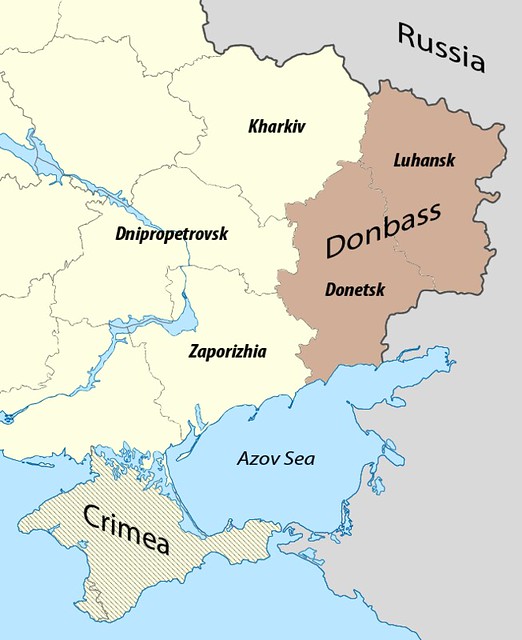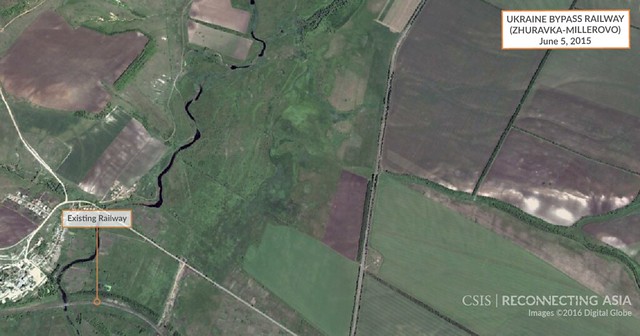Ukraine’s Frozen Conflict

Infrastructure in eastern Ukraine is desperately in need of repair and restoration as fighting in the region goes on, but patterns of infrastructure investment suggest that the Russian government does not expect the conflict to end any time soon.
Since 2014, Ukraine’s Donbas region has been the center of a war between pro-Russian separatists and the central government of Ukraine. In the course of the fighting, public infrastructure has been severely damaged. In 2015, the state road service of Ukraine, Ukravtodor, estimated the damage in Donbas at UAH 4.7 billion. The Ukrainian central government has recently earmarked UAH 3 billion to restore infrastructure in Donbas. Some external actors, such as German development bank KfW, are also trying to restore infrastructure in Donbas with infusions of cash. But infrastructure investment from Russia, which is supporting the separatist rebels, has been absent.

Despite the lack of investment inside eastern Ukraine, Russia is spending money, time, and personnel just outside the battle-scarred region, building bypasses around Ukrainian territory. One such bypass will go around the Ukrainian border between the Russian towns of Zhuravka and Millerovo. The 122.5km bypass (which you can find in our database) will replace a 26km railway that previously cut through Ukrainian territory, adding nearly 100km and spending billions of rubles to avoid passing through the Donbas near the de facto Luhansk People’s Republic (LNR).
Though the idea for the bypass has been circulating for years, Russian leadership decided to move forward with the project in late November 2014. Prime Minister Dmitri Medvedev said the bypass was necessary to ensure the uninterrupted transit of Russian trains “without being tied to the problems and trouble” in Donbas. The construction finally began in August of 2015 and has proceeded extraordinarily quickly, indicating a sense of urgency surrounding the project.

The Russian government expects that the construction will be finished by August 2017, a particularly fast turnaround for more than 100km of rail. To compare, it took Russia four years to build the Sochi – Adler – Sochi Airport Rail Line, which was only 2.9km in a safer and much more accessible location

The Russian Railway Troops, an arm of the Russian Ministry of Defense, are doing the excavation and laying the tracks for the construction. Important figures from the Ministry of Defense, including Defense Minister Sergei Shoigu and First Deputy Defense Minister Ruslan Tsalikov, have come to personally inspect the railroad’s progress, indicating that it is a vital project for Russia’s military. This construction and the attention that is heaped upon it signals that Russia has no expectation that Donbas will be hospitable to Russian trains, either due to continued violence in the region or a hostile Ukrainian state impeding trains’ movement.
There is no shortage of writing on the possibility of a frozen conflict in Donbas, and infrastructure investment is only one piece of the puzzle. Active armed combat has declined, but no political solution has truly ended the conflict, leading to violent flare-ups as tensions continue to simmer. Moscow has both the means and the motivation to keep the conflict frozen, as well as a history of doing so in post-Soviet areas such as South Ossetia, Abkhazia, Nagorno-Karabakh, and Transnistria, where it claims to be protecting Russian-speaking and other minorities.
Common Russian tactics for freezing conflicts include: introducing Russian currency, sending weapons and Russian fighters, and distributing Russian passports in the separatist regions. For example, the separatists in Donbas have adopted the ruble as their currency, and Russian has become the breakaway republic’s common tongue. There have also been reports of Russian weapons and fighters in Donbas since the beginning of the conflict. On the other hand, it is the separatists in the Donetsk People’s Republic (DNR) who have begun issuing their own passports, not the Russian government.
There is a logic behind these freezing tactics, including Russia’s railway plans. As long as the conflict remains frozen, Russia can exert control over the separatists and gain leverage over other governments without taking on the burden of providing a full array of government services or rebuilding infrastructure in Donbas. Russia has not invested in infrastructure in Donbas so far, and there is no evidence that they intend to start. Freezing the conflict gives Russia influence and leverage without the obligations that come with annexation.
Annexation would be an expensive process for Russia, both economically and diplomatically. Since the annexation of Crimea, Russia has faced sanctions and diplomatic isolation from the West. Annexing more territory would lead to further repercussions from the international community. In addition to diplomatic consequences, Russia would inherit responsibility for the welfare of the breakaway territories. With the economic downturn in recent years, Russia has had trouble providing basic services for Russians within their existing borders, struggling to cover massive deficits in the pension program and cancelling Russian infrastructure projects as money gets tight.
Rather than taking on the burdens of annexation, freezing the conflict leaves Donbas as a perpetual thorn in Kyiv’s side, eating up resources and attention that could be spent reforming the government and building relationships in the West.
If Donbas returns to Ukrainian control under the Minsk agreement, separatist groups become legitimized political forces. A drawn-out frozen conflict crystallizes separatist resentment and hostility. That resentment makes it more difficult for the Verkhovna Rada to effectively govern the region. Regardless of whether or not the Minsk agreement formally resolves the conflict in Donbas, Russian-supported separatists will continue to cause problems for the Ukrainian government. Infrastructure may be only one piece of a larger picture, but Russian patterns of investment suggest that the Russian government has no expectation of stability for the region.
Brina Malachowski is a researcher with the Reconnecting Asia Project at the Center for Strategic and International Studies.